Modern engineering education
Herbert
Hoover (seated left) and Stanford Surveying Squad
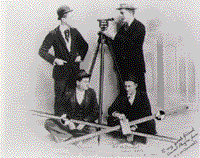 Herbert Hoover said that in his lifetime (1874-1964)
engineering
changed from a trade to a profession (Florman ch. 18 quotes
from Hoover's memoirs, published in 1954 but here is a link to some quotes by
Hoover
on engineering).
Florman notes several changes, not all of them towards more
professionalism:
Herbert Hoover said that in his lifetime (1874-1964)
engineering
changed from a trade to a profession (Florman ch. 18 quotes
from Hoover's memoirs, published in 1954 but here is a link to some quotes by
Hoover
on engineering).
Florman notes several changes, not all of them towards more
professionalism:
- change from rule-of-thumb experience to
formal
science
- change from apprenticeship to formal
education
- change from independent consultant to
corporate
employee
- Florman says (p. 173) that
the status of the profession declined
Engineering education has not changed much in form
since
1900, but it has changed a lot in content. Some
key areas of tension and change are:
How has engineering education changed as
the profession has changed, to prepare people for their careers?
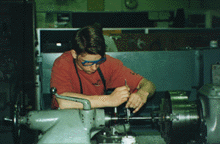
image
credit
Continuing tension between science and hands-on
practice:
In 1906 the University
of Cincinnati pioneered co-op education--students did no practical
work at school but learned it in their industrial work. Initially
they alternated weeks.
In 1918 the Mann report complained about
overspecialization
in engineering schools and called for more laboratory teaching of
engineering.
In 1932 an organization was set up to set
standards
for engineering schools: ABET
(Accreditation Board for Engineering and Technology).
- Engineering schools, in order to be
accredited
(as meeting
standards for the graduates to be licensed) must follow standards
set by ABET
- ABET sets general standards for the courses
students must
take: for example the requirement that students must take 3
distribution
courses in one field or 2 in each of 2 fields comes from ABET
- it also sets standards for everything from
student labs
to graduate student offices
Florman thinks engineers should study more liberal
arts? Why?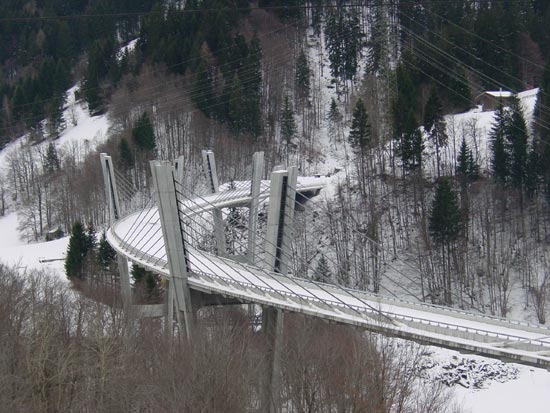
- technical/vocational education vs. liberal
arts
- cultural literacy
- creativity--see for example the bridges of Christian
Menn and the ideas of David
Billington
A lot of what engineers do with their time requires
nontechnical
skills:
- An MIT study of Exxon found that engineers
and
intermediate
managers spend 30% of their time writing, while supervisors spend 40%
of
their time writing. ( Paradis, James, David Dobrin, and
Richard
Miller. “Writing at Exxon ITD: Notes on the Writing
Environment
of an R&D Organization.” Writing in Nonacademic
Settings.
Ed. Lee Odell and Dixie Goswami. New York, NY:
Guilford
Press, 1985. 281–307. )
Is something lost in focusing only on technology?
- In Nazi Germany, engineers, chemists and
other
professionals
were assigned the task of finding more efficient ways of killing people
(see for example a biography of Eichmann
or selections from an eyewitness
account). Most of them did so, even those who were not
members of the Nazi party, treating the extermination of a people as
simply
another technical problem to be solved. Engineers must see the
big
picture and be knowledgeable about contemporary affairs to prevent that
ever happening again.
One solution would be a 5 year engineering degree
or requiring a masters degree for licensing,
as in almost all other professions. But this idea has never
gotten
much support.
Engineers increasingly worked for big businesses
- By 1930 well over 90% of engineers were
employed
as technical
workers or as managers in industry, rather than being independent
professionals.
- In a study of 1884-1924 roughly 2/3 of
engineers
became
managers within 15 years after college.
- Does engineering education prepare engineers
to
become
managers?
- MIT re-emphasized the humanities in the
early
20th century
partly with the idea of preparing engineers to make the cocktail party
conversation necessary to move up in management.
- if you work for a large corporation can you
really be
a professional who puts the public good first?
How has engineering changed as society
has changed?

Sputnik
1
Increasing government role and increasing diversity:
impact of Sputnik
(in 1957 the Russians launched the first artificial
satellite--Americans
were very upset about the Russians being ahead):
- National Defense Education Act of 1958
- a major effort to improve secondary school
teaching with
such things as "new math"
- "manpower" concerns--first efforts to
encourage
women
to study engineering
- the following chart shows the percentage of
engineering
degrees going to women. The top of the chart is 20%
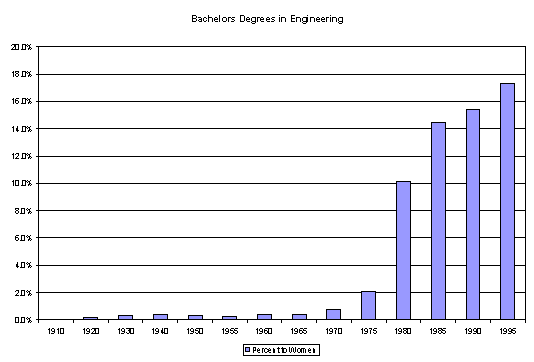 How has diversity changed engineering?
How has diversity changed engineering?
How changes in technology have changed
engineering and engineering education
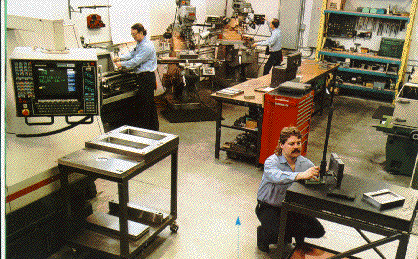
image credit
Impact of Computers:
Modeling rather than hands-on testing
Computer Aided Design (CAD): the computer can do
the
drafting and calculations during the design process
Computer Aided Manufacturing and Computer
Numerically-Controlled
Machine Tools: A computerized system automatically sets up the
manufacturing
system or machine tool to produce the product called for by the CAD
drawings.
Expert systems to replace engineers?
Teaching with technology
What else?
Because of the expense of these systems it has
become
harder for engineering schools to keep up with the technology being
used
in industry.
How do the changes in engineering education
compare with how education for other professions has changed?
Quote
of the day:
- Engineering is a great
profession. There is the satisfaction of watching a figment of the
imagination emerge through the aid of science to a plan on paper. Then
it moves to realisation in stone or metal or energy. Then it brings
homes to men or women. Then it elevates the standard of living and adds
to the comforts of life. This is the engineer's high privilege.
- Herbert Hoover, US mining engineer
& politician (1874 - 1964)
This page written and copyrighted by Pamela E. Mack
last updated 9/5/2005






